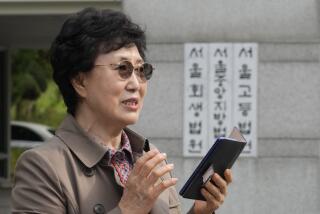Building Black Families : Nonprofit Group Helps Make Dreams of Adopting a Reality
- Share via
WEST LOS ANGELES — By most measures, Doris J. Sims has made it in life. A professor at Cal State Los Angeles, Sims lives in a comfortable neighborhood in West Los Angeles. A single woman in her 40s, she had already received her Ph.D. and thought she had reached the apex of her career.
But something was missing, Sims said. She kept feeling there should be more to life.
For her, there was more: 3-year-old Andrew Mark Sims, whom she adopted as her son in May.
“I was transformed into a mother overnight,” said Sims, who still seems delighted and amazed by her new status.
The journey toward motherhood began about 2 1/2 years ago when Sims attended an orientation by the Institute for Black Parenting. The private, nonprofit group in Inglewood recruits black families for foster care and adoption in Los Angeles County.
Sims said she went along with her sister to the meeting only because her sister was interested in working with children. But it was she who ended up filling out an adoption application.
The meeting affirmed for her that “I may not be a wife, but I can be a mother,” she said.
In May, two days before Mother’s Day, she welcomed Andrew into her home.
Since opening its doors in 1988, the institute has placed hundreds of African-American children with single parents and couples, thanks to its aggressive recruiting and publicity from entertainers and social service groups.
The institute seeks to chip away at the backlog of African-American children in Los Angeles County awaiting adoption. Though blacks account for only 10% of the county’s population, more than 60% of the 140 youngsters now awaiting adoption through the Department of Children’s Services are African-American, county officials say.
Zena Oglesby, the institute’s founder, said his organization proves every day that this problem can be solved. “We’ve been exploding the myth that black families do not adopt,” Oglesby said.
He acknowledges that the institute’s challenge is huge.
In many cases, myths about adoption have created an imaginary wall separating potential parents from black children who are available for adoption.
A common misperception is that black children in the foster care system are either emotionally disturbed or addicted to crack, Oglesby said. He estimates that only a third of the black children in foster care have such troubles.
“Another third of the children are normal, but they’ve moved around too many times,” Oglesby said. “Because they’ve been in 12 to 15 foster homes, they look really crazy. . . . They don’t trust you. And the other third are normal and healthy, doing well in school, and have had only one foster home placement.”
Oglesby added: “Their only crime is being black and over the age of 3.”
For Sims, the only special needs Andrew had were for a stable home and a mother’s love.
Andrew, who will be 4 in September, had been in foster care for the first three years of his life when an emergency in his foster family forced him to be relocated to a temporary foster home.
Sims said that when she first met her son, he was very withdrawn and quiet. He was missing his foster mother terribly, he was surrounded by a roomful of new faces, and he was under medication for hyperactivity.
But in the four months since they became a family, the boy with the “huge, beautiful eyes” has blossomed. “Everyone adores him,” she said, and he has turned out to be a real people person.
Sims, a professor of child and family studies, has since taken Andrew off of Ritalin, a medication for attention-deficit disorders, because much of his behavior was normal for his age, she said.
“He’s active but he’s a typical little boy. His behavior is developmentally appropriate,” she said.
The institute took great care to disclose every bit of information they could about the child’s background, Sims said.
A caseworker “gave me everything she had on him,” including the drugs Andrew was exposed to prenatally, information on his biological mother and father and siblings, and the child’s medical and psychological profile.
A serious barrier to exploring adoption for some blacks is the fees charged by private adoption agencies, which in some cases amount to $20,000. Many think the prerequisites for adoption include marriage, high income and home ownership.
For blacks who choose to adopt through the county, the cost is significantly lower--about $500--but the process can be daunting. For example, frequent treks to the Department of Children’s Services in the mid-Wilshire area are not easy for people who work 9 to 5.
And the bureaucracy, some say, can be off-putting to black adoptive parents.
In 1986, actor Taurean Blacque, who was a cast member on “Hill Street Blues,” attended an adoption fair sponsored by the county.
“I talked to a social worker and told her I was interested in adopting a child,” said Blacque, who had already raised two sons. “She told me that (adopting) was impossible, because ‘You’re a male, you’re single, and you’re black.’ ”
Blacque would not be denied. “I am still single, male and black--11 (adopted) kids later,” he said, laughing, adding that the adopted youngsters range in age from 2 to 15.
Although she is a single mother, Sims said she was encouraged to persevere with her plans to adopt a child. She acknowledges that she has gotten lots of help since Andrew came into her life, particularly from her family of five brothers and sisters. It has also helped enormously that Cal State Los Angeles provides child care services while she is teaching.
Friends, family and colleagues have been genuinely supportive, she said. “People want to put a big star on me. They think it’s the greatest thing, because adoption is something you choose to do. Wherever I go, the response is overwhelming. They’re just so pleased.”
Blacque, now a spokesman for the institute, said the Inglewood group helped him with some of the adoptions and, perhaps more important, with valuable information.
“(The institute) really helped me, as far as knowing my rights,” he said. “They told me about the Adoptions Assistance Program, where you can get financial help for adopted children who have physical or emotional problems. It’s government funding, but the county didn’t let me know about AAP.”
County officials acknowledge that problems exist with their adoption system, but they say they have made progress in correcting them. To encourage more black families to adopt, they point out, the Department of Children’s Services created a local version of the “One Church, One Child” program that originated in Chicago. Under the program, county social workers visit black churches and speak to the congregation to recruit people interested in adoption.
“Adoptions are going up dramatically through the efforts of our agency, and through the collective efforts of people working with the county,” said Schuyler Sprowles, a spokesman for the Department of Children’s Services.
Indeed, adoptions of black children are on the rise not only locally, but also statewide. Last year, the county handled 438 adoptions involving black children, compared to 298 in 1989. Statewide, there was a 91% jump in the number of black adoptions--from 558 in the 1988-89 fiscal year to 1,065 in 1991-92.
The institute has played a key part in improving the situation. In its five years of operation, it has placed 250 black children in adoptive homes, and 350 in foster care. Of those in foster care, Oglesby said most will be adopted. Last October, the institute opened an office in Riverside to serve the Inland Empire.
Aggressive recruiting of black parents is supported by public service announcements on radio and cable TV featuring such celebrities as Blacque and Blair Underwood of “L.A. Law.” The institute also works with the children’s services department, churches and other community institutions to find adoptive parents.
For families looking to adopt, the institute offers advantages. Funded mainly through private donations and government grants, it charges no fees. But its staff members visit the homes of black families interested in adoption and provide other services, ranging from assistance with paperwork to attorney referrals.
Sims said the agency is very thorough in evaluating prospective parents, but the emphasis is more on finding a secure home for the child than on financial statements.
“We cater to single parents, low-income families, the middle class--those (black) families that we find functional in the African-American community,” Oglesby said.
Reaching such families, however, has not always been easy, a fact that Oglesby first learned in 1976, when he became the first black adoption caseworker in San Bernardino County. His assignment was to find black families who would adopt.
“They gave me 22 cases, and they were all African-American children. The agency had only approved two families during the previous five-year period.”
He went house-to-house and got a lot of doors slammed in his face. “I was beginning to believe the myth, that black people don’t care about their own.”
But Oglesby met with a local Urban League member, who suggested they go to churches to recruit. “The Urban League guy gave the same speech I had given, but after he spoke the people formed a line to sign up for adoption,” he said.
It occurred to him that to succeed, black adoption efforts had to be conducted through community organizations, not the government, which many blacks consider hostile.
To that end, Oglesby approached the state Department of Social Services in 1988 and secured a $250,000 grant to start the Institute for Black Parenting. He and a staff of two rented office space at Western Avenue and 71st Street in Inglewood. The agency moved last year to its offices on La Cienega Boulevard, near Los Angeles International Airport, and now has a $3.2-million annual budget and a staff of 41, including social workers, child psychologists and a public relations crew.
At the root of that success are people like Edwina Lewis. A 32-year-old social worker, she had never considered becoming a single parent. But two years ago she became acquainted with 4-year-old Sean.
“I was his social worker, and I helped place him in an appropriate foster home,” said Lewis, an Inglewood resident who has been with the Department of Children’s Services since 1985.
Sean had been labeled “developmentally delayed.” He stuttered and was painfully shy. He was struggling to learn English because the foster family he had lived with since infancy spoke Spanish.
Lewis started to spend time with Sean and got him enrolled in a Head Start Program. When she decided to adopt the boy, she contacted the institute, since handling the adoption through the county would have been a conflict of interest.
“I was impressed with the (institute’s) social workers. The application process went quickly. The assessments were right on target, and it turned out that Sean didn’t need speech therapy,” she said.
A year later, Sean is an honor student and “a little socialite,” Lewis said. “Kids just need to be in a place where they are loved and cared for. It’s a wonderful thing, to see Sean come into his own.”
More to Read
Sign up for Essential California
The most important California stories and recommendations in your inbox every morning.
You may occasionally receive promotional content from the Los Angeles Times.













